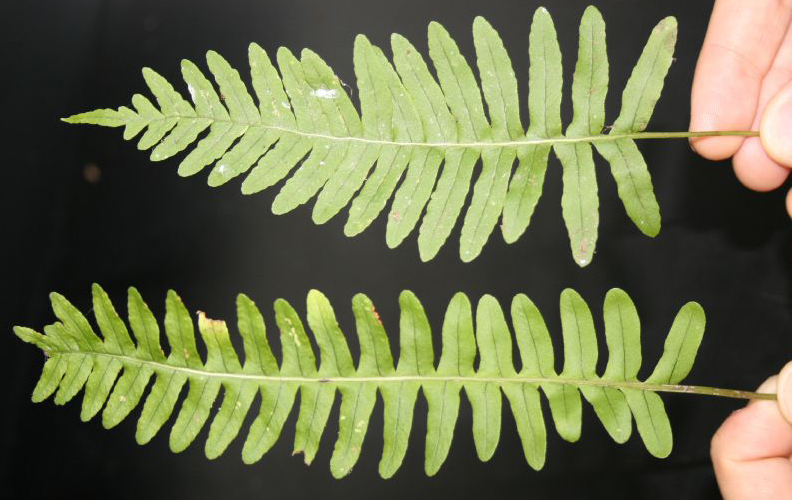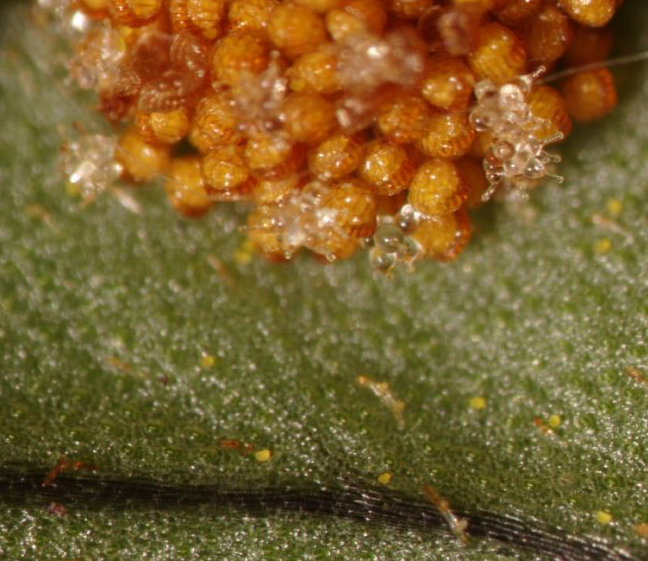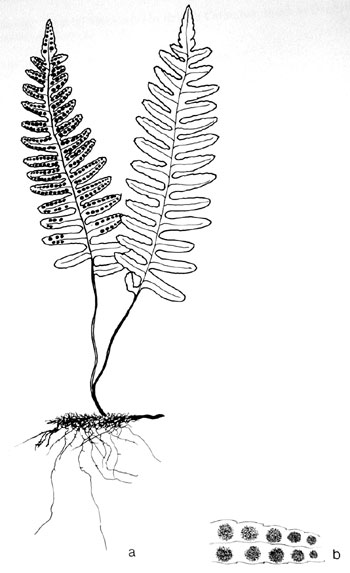|
Hardy Fern Home P. virginianum resources
All Ferns � Polypodiaceae �� Polypodium
�Other Genera
|
| Polypodium virginianum | ||
Rock polypody, Rock-cap fern | ||
|
Etymology
Virginianum describes the area of Virginia, which in the seventeenth century was a huge tract of land in eastern North America.
Description
Rhizome: long-creeping, producing rows of fronds, occasionally branching, whitish pruinose, slender, to 6 mm diam., at the surface, scales lanceolate, base and margins light brown, sometimes with dark central stripe.
Frond: 40 cm high by 7 cm wide, evergreen, last year's fronds withering as this year's appear in early summer, monomorphic, blade/stipe ratio: 3:2 to 3:1. Stipe: jointed at base, straw-colored, glabrous or scattered with thin light-brown scales, vascular bundles: 3. Blade: pinnatifid, cut almost to the rachis, oblong to narrowly lanceolate, usually widest near middle, occasionally at or near base, leathery, rachis glabrous above, sparsely scaly below; scales lanceolate-ovate. Pinnae: 9 to 18 pair, linear, entire to slightly dentate, apex rounded; margins entire to crenulate; apex rounded to broadly acute; veins free, forked, obscure. Sori: round, discrete, midway between margin and midrib to nearly marginal, at vein ends; on all but the lowest pinnae of fertile fronds, indusium: absent, sporangia: yellow to brown at maturity; paraphyses (branching structures among the sporangia) present, maturity: summer--fall. Dimensionality: lowest pinnae bending down, forward; frond rolling up to the rachis (above the plane) when desiccated. Culture
Habitat: cliffs and rocky slopes; on a variety of substrates.
Distribution: north-central Canada south to Arkansas, east to North Carolina, north to Newfoundland; also perhaps Japan, Korea, Mongolia, eastern Siberia.
Hardy to -40�C, USDA Zone 2, but given the range, provenance may be important.
Synonyms
Polypodium vinlandicum A. L�ve & D. L�ve Polypodium vulgare Linnaeus var. americanum Hooker Polypodium vulgare var. virginianum (Linnaeus) D. C. Eaton Polypodium vulgare ssp. virginicum Fernald Compare with other species in the Eastern Asia Group
Compare with other species in the Eastern North America Group
|
|
|
Notes
Compare to P. virginianum was known as P. vulgare for many years and can still be found under that name on many web sites. North America is now regarded as not a home to P. vulgare. Distinguishing these two (or, for that matter, any pair of polypodies) is nonetheless difficult. Differences:
P. virginianum has rhizome scales with a central, darker brown stripe, stipes are scaly, sori are midway between the costa and margin OR closer to the margin (particularly on the basal side of the pinna), sori have paraphyses (branching structures among the sporangia, hand lens required).
P. vulgare has brown rhizome scales with no central stripe, stipes are glabrous, sori are midway between costa and margin OR closer to the costa, sori have no paraphyses.
Compare to Fronds of Polypodium appalachianum� and P. virginianum in the photo below: three characters differ: pinnules pointed on P. appalachianum, pinnules rounded on P. virginianum; blade triangular, widest near base with P. appalachianum, blade with more parallel sides, often widest at the middle, for P. virginianum; lowermost pinnule meets rachis creating a distinct notch in P. appalacianum, hard to see here, but click through to the original, somewhat clearer. The apex of lower frond is aberrant.
Parents P. appalachianum and P. sibiricum, both of which differ in minor ways and the latter not cultivated. The former is wider at the base of the blade.
Taste Most of the floras mention an acrid taste; sometimes unstated, this is a means of distinguishing between this and P. glycyrrhiza, the licorice polypody.
Compare to P. virginianum was known as P. vulgare for many years and can still be found under that name on many web sites. North America is now regarded as not a home to P. vulgare. Distinguishing these two (or, for that matter, any pair of polypodies) is nonetheless difficult. Differences:
P. virginianum has rhizome scales with a central, darker brown stripe, stipes are scaly, sori are midway between the costa and margin OR closer to the margin (particularly on the basal side of the pinna), sori have paraphyses (branching structures among the sporangia, hand lens required).
P. vulgare has brown rhizome scales with no central stripe, stipes are glabrous, sori are midway between costa and margin OR closer to the costa, sori have no paraphyses.
Compare to Fronds of Polypodium appalachianum� and P. virginianum in the photo below: three characters differ: pinnules pointed on P. appalachianum, pinnules rounded on P. virginianum; blade triangular, widest near base with P. appalachianum, blade with more parallel sides, often widest at the middle, for P. virginianum; lowermost pinnule meets rachis creating a distinct notch in P. appalacianum, hard to see here, but click through to the original, somewhat clearer. The apex of lower frond is aberrant.
Parents P. appalachianum and P. sibiricum, both of which differ in minor ways and the latter not cultivated. The former is wider at the base of the blade.
Taste Most of the floras mention an acrid taste; sometimes unstated, this is a means of distinguishing between this and P. glycyrrhiza, the licorice polypody.

Polypodium virginianum. Three vascular bundles at both the stipe base (below) and the stipe apex where they unite. �Drawing from Ferns of Northeastern United States, Farida A. Wiley, 1936. |

Polypodium appalachianum above and P. virginianum below. See the note for an explanation. �Robbin Moran |

Polypodium virginianum.� Paraphyses, the translucent, glandular structures among the sporangia in the sorus. Under a microscope in this photo, but you can see the paraphyses with a hand lens. �Robbin Moran |
